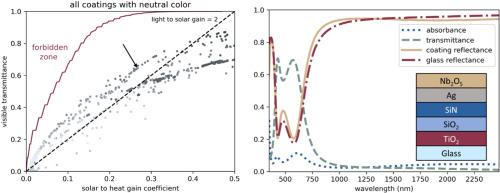低辐射涂层的优化设计
IF 6.3
2区 材料科学
Q2 ENERGY & FUELS
引用次数: 0
摘要
我们报告了一项全面的数值研究,结果表明仅由 5 层组成的低辐射(low-E)涂层具有令人惊讶的良好光能性能。模拟在传递矩阵框架内进行,同时使用遗传算法进行多目标优化。结果表明,在使用只有一层银层的传统电介质材料时,所有银层都能以最佳厚度排列成多层叠层,从而实现较大的光太阳增益(LSG)比和可见光透过率(VT),分别高达 2.4 和 0.72,并具有中性色彩(在 CIELAB 色彩空间中,a∗=-3±1 和 b∗=-5±1)。单金属玻璃如此出色的性能可以用开放式法布里-佩罗空腔(所谓的伪空腔)的出现来解释,这对于以传统金属-电介质-金属法布里-佩罗空腔为中心的低辐射工业来说是一个不同寻常的概念。我们的工作凸显了大规模计算优化对设计高效低辐射涂层的重要性,并为该领域的未来发展提供了有益的指导。本文章由计算机程序翻译,如有差异,请以英文原文为准。

Optimal design of low-emissivity coatings
We report a comprehensive numerical study demonstrating surprisingly good photoenergetic performance of low-emissivity (low-E) coatings comprised of just 5 layers. Simulations are performed within the transfer-matrix framework in conjunction with multiobjective optimization using a genetic algorithm. We show that upon utilization of conventional dielectric materials with only one silver layer, all that arranged in a multilayered stack with optimal thickness, large light-to-solar gain (LSG) ratio and visible transmittance (VT) up to 2.4 and 0.72, respectively, with neutral color ( and in CIELAB color space) can be achieved. Such an outstanding behavior of single-metal glazing is explained by the emergence of open Fabry-Pérot cavity (so-called pseudo-cavity), the unusual concept for the low-E industry centered around conventional metal-dielectric-metal Fabry-Pérot cavities. Our work highlights the importance of large-scale computational optimization for the design of efficient low-E coatings and provides a useful guide for future developments in this field.
求助全文
通过发布文献求助,成功后即可免费获取论文全文。
去求助
来源期刊

Solar Energy Materials and Solar Cells
工程技术-材料科学:综合
CiteScore
12.60
自引率
11.60%
发文量
513
审稿时长
47 days
期刊介绍:
Solar Energy Materials & Solar Cells is intended as a vehicle for the dissemination of research results on materials science and technology related to photovoltaic, photothermal and photoelectrochemical solar energy conversion. Materials science is taken in the broadest possible sense and encompasses physics, chemistry, optics, materials fabrication and analysis for all types of materials.
 求助内容:
求助内容: 应助结果提醒方式:
应助结果提醒方式:


